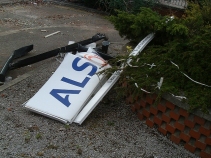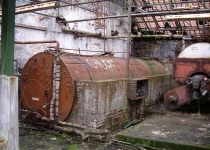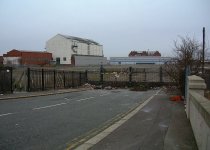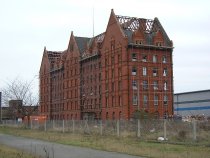

MANUFACTURING IN DECLINE
The manufacturing industry in the UK has shrunk over the past years with many famous companies either closing completely or moving their operations abroad. This has often been brought about because of high labour costs and because companies did not adapt quickly enough to changing markets. In the case of Marconi, for example, they risked their future business on a dot com bubble that wasn't sustainable and didn't last.

Having worked in industry for over 30 years, I find it very sad but also fascinating to visit abandoned factories and offices. As part of my job I had responsibility for managing the orderly closure and withdrawal from a variety of sites including GEC at Trafford Park and Openshaw in Manchester, Railcare at Coventry and Metro-Cammell at Washwood Heath in Birmingham. Although every abandoned site is different they all have the same "trade mark" features of decay: the solitary coat hanger, cup stains on desks, peeling paint, mouldy chair seats, the long forgotten dead plant, abandoned files and paperwork. There are sometimes bizarre situations where items are left exactly where they were last used: the sack truck in the middle of an office, a half drunk cup of tea now evaporated to a green sludge, personal mementoes discarded.

There is something odd about the final weeks and days of a site that's about to close for good. The usual method and order seems to evaporate and what used to be important is no longer. There is a strange combination of panic (we'll never get this office cleared in time) and apathy (oh leave it behind) that emerges towards the closure date. Plans to archive documents, collect together mementoes and to empty desk drawers all fall victim to time. Something that seemed important a month before closure becomes less so as closure approaches. Carefully filed documents are discarded or shredded, litter is abundant, damaged items go unrepaired and a coat stand that falls over is left where it is. Sodden carpets beneath windows that nobody bothered to close.

You can usually find out when an office closed - just look for a calendar and it'll probably show the month and year when the last staff left. Also look at the days and you'll often find some wry comments on the days just before closure! The final day usually has its own peculiar attributes.
Derelict sites can be even more depressing with their extreme flatness punctuated only by the occasional electricity substation or other structure
that can't be demolished. Any buildings that remain have usually had their windows smashed so diligently that rarely a whole pane survives.
Occasionally though, a building is carefully dismantled so that its timber, brick and embellishments can be recovered and re-used. Although
the materials are scattered to different locations they have at least been salvaged.

There's an excellent collection of salvaged stone and terracotta bricks, balusters, copings, corbels, cornices, finials, gargoyles and so on at the City Museum in St Louis, USA.
This page provides a few links to other web sites that chronicle the demise of British industry whether it be engineering, electronics, chemicals or whatever. Hospitals and government sites feature heavily. Also listed are links to sites about the Cold War and military sites.

- 28 Days Later is a UK urban exploration forum with a good deal of information and photographs.
- Derelict Places is very similar to 28 Days Later but has some interesting additional information on trespass and health and safety precautions
- Urban Assault used to be at www.urbanassault.t83.net but is now defunct. It used to document buildings and structures that are derelict and abandoned, places that are normally unseen by the general public.
- Urbex Nation was a directory of sites with few photographs but is now defunct. It was at www.urbexnation.co.uk. Stop press and shiver me timbers; Urbex Nation is back at the old URL. Sorry , it's gone again.
- underground-history.co.uk is all about the London Underground, its closed stations, history and how parts of it were used as shelters during WW2.
- Subterranea Brittanica is probably the definitive site for all Cold War and military bunkers and other man-made underground sites.
- Derelicte used to document derelict buildings in East Anglia and sometimes beyond. However, the website is now dedicated to urban regeneration though it has very little content (2021).
- Terra Stories covers a number of sites in the USA and elsewhere. It contains detailed descriptions of the explorations.
- Industrial Britian doesn't have many sites at the moment but looks promising for the future.
- Forlorn Britain was an excellent site detailing a number of derelict and abandoned sites. However, it is now defunct but can be viewed in archive form at archive.today. Note that the original URL has been re-used for other purposes.
- NGTE at Pyestock is all about about Pyestock, the former National Gas Turbine Establishment, located in Farnborough, UK. Conceived in the build up to World War Two, and realised in the post-war paranoia of the opening virtual salvos of the cold war, Pyestock was one of a number of top-secret sites which would bolster the UK's standing during the austere 1950s; and become a vital component of the White Heat of Technology in the twitchy 1960s.
- Mine Explorer was a "mine" of information about mines up and down the UK. However, the site is currently closed for redevelopment.
- Various sites in and around Kent. Currently there's no content.
- Derelict London comprises all sorts of topics: architecture, waterways, sports grounds, etc.